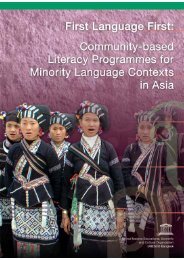Part II.pdf - MTB-MLE Network
Part II.pdf - MTB-MLE Network
Part II.pdf - MTB-MLE Network
You also want an ePaper? Increase the reach of your titles
YUMPU automatically turns print PDFs into web optimized ePapers that Google loves.
• Establishment/strengthening of the Community Learning Centres<br />
The community learning centre aims to provide learning opportunities and community development<br />
activities to different types of learners in the community. The activities to be undertaken will<br />
eventually improve the living conditions of the people through lifelong learning.<br />
2. Bilingual Policy<br />
The 1987 Philippine Policy on Bilingual Education under the auspices of the Department of Education<br />
aims to achieve of competence in both Filipino and English at the national level through the teaching<br />
of both languages and their use as media of instruction at all levels. The regional or mother tongue<br />
shall be used as auxiliary languages in Grades I and <strong>II</strong>. The regional language or mother tongue<br />
shall also be used as the initial language for literacy, where needed.<br />
DECS Order No. 80 s. 1999 specifies that the medium of instruction in all learning areas in<br />
Grade I will be taught in the lingua franca widely spoken in the community where the school is<br />
located, which may be Tagalog, Ilocano, Cebuano or other dialects. The teaching of English as<br />
a subject will be done orally in the second semester.<br />
Under the Non-formal Education Programme, the lingua franca or the mother tongue as spelled<br />
out in the 1987 the Philippine Policy on Bilingual Education should be used as the medium of<br />
instruction in literacy sessions. In order to preserve the use of the mother tongue and to facilitate<br />
the easy acquisition of the basic skills and competencies by the IP learners, literacy facilitators<br />
should preferably be qualified members or residents of IP communities who can speak the language.<br />
These processes are valuable in addressing the problem on the diminishing use of the mother tongue<br />
among the younger generation brought about by intermarriage and assimilation with other people<br />
in the neighboring communities.<br />
3. Current Scenario of Indigenous Peoples in the Philippines<br />
In 2004, the total Philippine population is projected to be around eighty-two million people,<br />
11.8 million of whom are indigenous peoples. The majority of the 11.8 million IPs are found in<br />
Regions XI and X, while the least number are found in Region V<strong>II</strong> and the National Capital Region.<br />
Currently, most of the indigenous peoples in the Philippines still experience discrimination/<br />
differentiation as reflected by the following situations:<br />
Culture and Educational Situation<br />
• The IPs are the most uneducated and the least to benefit from the social services and<br />
educational opportunities provided by the government<br />
• IPs are still perceived as second class citizens<br />
• Traditional knowledge, practices, and culture of indigenous peoples are dying out<br />
• World views of the young and old differ due to the assimilation processes<br />
• Non-formal education is appropriate for indigenous peoples, but often not sufficient in<br />
content and length of time<br />
183
















